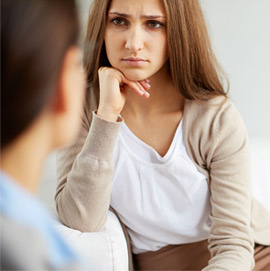Mental Health Services
 Oasis provides expert and compassionate care to children, adolescents and adults.
Oasis provides expert and compassionate care to children, adolescents and adults.
Our board-certified psychiatric nurse practitioners, therapists and social workers specialize in treating most mental health disorders, including anxiety, depression, and bipolar disorder.
Whether you know your specific needs, or you are looking for help but don’t know where to start, we work closely with you to ensure you get the safe, effective treatment you need.
Common signs and symptoms of mental health disorders:
In Adults:
Depression is a mood disorder that affects about 7 out of 100 women and 3 out of 100 men. Common symptoms include sadness, hopelessness, irritability, inability to feel pleasure, lack of energy, changes in sleep and appetite, and thoughts of suicide. These symptoms interfere with daily life and last for weeks or longer. Depression runs in families and frequently co-occurs with anxiety disorders, eating disorders, and substance abuse.
In Adolescents and Children:
Depression is a mood disorder characterized by irritability, a dramatic change in appetite and/or sleep, feelings of sadness and/or hopelessness, a loss of interest in things that used to be pleasurable, isolation, and thoughts of suicide.
It affects boys and girls equally during childhood. However, during adolescence, the depression rate for girls doubles to 5 out of 100, yet remains the same for boys.
Depression often co-occurs with other disorders, particularly anxiety disorders, attention deficit hyperactivity disorder (ADHD), eating disorders, and conduct disorder.
Bipolar disorder is a mood disorder characterized by alternating episodes of depression (see Depression) and mania.
In Adults – manic symptoms include:
- Racing thoughts
- Irritability
- Decreased need for sleep
- Reckless behavior
- Feelings of invincibility
Mood episodes may last anywhere from days to years. Bipolar affects men and women equally at the rate of about 1 out of 100 people; however, this rate may be as high as 22 out of 100 in people with first degree relatives who have bipolar disorder.
In Adolescents and Children – Manic symptoms include:
- Irritability
- Rage
- Aggression
Other manic symptoms include:
- Racing thoughts
- Decreased need for sleep
- Reckless behavior
Children may experience multiple mood swings in one day or experience “mixed” episodes with characteristics of both mania and depression at one time. Some symptoms may look like ADHD.
Further, the disorder often co-occurs with other disorders, especially ADHD, conduct disorder, anxiety disorders, and substance use. The overlap in symptoms makes it difficult to diagnose and the prevalence is unclear.
GAD is an anxiety disorder marked by excessive worry over multiple, often minor, events.
In Adults:
People with GAD have difficulty controlling their worry even when they recognize a worry is unfounded. GAD affects about 5 out of 100 people and is slightly more common in women than men.
It often co-occurs with another anxiety or mood disorder, especially depression. In addition to psychotherapy and psychopharmacology, applied relaxation is shown to be helpful.
In Adolescents and Children:
GAD is usually accompanied by at least one physiological symptom such as difficulty concentrating or restlessness.
Children with GAD have difficulty controlling their worry and frequently ask, “What if”… questions.
GAD affects about 6 out of every 100 children and adolescents. It often co-occurs with another anxiety or mood disorder, especially depression. In addition to psychotherapy and psychopharmacology, applied relaxation can be helpful.
OCD is an anxiety disorder characterized by the presence of unwanted repetitive thoughts, images, or urges (obsessions).
In response to these obsessions, a person may have a drive to perform a repetitive behavior (a compulsion) usually with the goal of reducing anxiety caused by the obsession.
OCD affects approximately 5 people out of every 100 people, is slightly more common in females than males, and is frequently accompanied by depression and other anxiety disorders.
Individuals directly exposed to events involving death or serious injury may respond with intense fear, horror and/or feelings of helplessness.
They may relive the event, avoid situations that remind the person of the event, feel numb, and be keyed up.
In about 1-12% of such instances, the person develops the anxiety disorder, PTSD, meaning these symptoms last longer than four weeks, cause great distress, and interfere with the person’s daily life.
Social phobia is an anxiety disorder characterized by a marked fear of social or performance situations. When exposed to such situations, the person experiences extreme anxiety or a panic attack.
Individuals with social phobia may have few friends, be reluctant to join group activities, and describe themselves as lonely.
Social phobia affects about 8 out of every 100 people.
